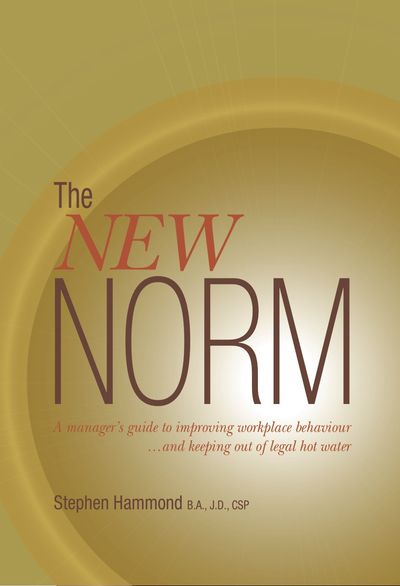Chapter fourteen
THE NEW NORM celebrates pregnant employees
Alison MacKinnon gave a week’s notice at an optical store to take a new job. She began work at the Inn on the Hill hotel in Charlottetown, Prince Edward Island on September 20, 2010 as an administrative assistant, working the front desk. Less than a month later she informed her supervisor Tanya Bevan that she was pregnant.
Forty minutes later MacKinnon was called into the office of Tanya Bevan and the general manager, Roger Bevan, where she was told her employment was being terminated, although she could work for another two weeks if she wanted, while looking for another job. She chose not to, as she said she was told they “didn’t like her.”
Both the general manager and her supervisor said this was all bad timing because they had already decided to let her go the next day, because of the way she dressed and her inability to do her job properly. However, nothing had been mentioned previously about her performance or the way she dressed.
Since this was during her six-month probationary period, they felt they had every right to let her go. MacKinnon made a complaint to the Prince Edward Island Human Rights Commission. When the complaint couldn’t be settled, both parties ended up at a human rights adjudication, which was made public in February, 2012.
The problem with a situation like this is that you have conflicting “rights.” The employer, like most employers, believed it’s allowed to let an employee go for any reason as long as it’s during the probationary period.
Employers feel that’s an employer’s right. On the other hand, an employee has the right to be free of discrimination, and since pregnancy is a human rights protected ground (usually under the characteristic of “sex” or “gender”), this employee felt her new employer didn’t have the right to fire her after she revealed she was pregnant.
The owners of this Inn would have benefited from taking my Respectful Workplace online course, where we go right into issues of discrimination based on pregnancy and how to avoid various forms of sex discrimination at work.
The adjudicator made reference to a different PEI Court of Appeal decision in which the court said that even during a probationary period an employee must be given a “reasonable opportunity to prove he is suitable for permanent employment” and that it’s not enough to “terminate him and [tell] him it didn't work out.”
Hence, it’s not a free-for-all when it comes to probationary periods from an employer’s standpoint. But when it comes to the issue of protecting women who are pregnant, or might become pregnant, the law is quite clear.
The adjudicator noted that regardless of the probationary issue, “employers are still held to the standards contained within the Human Rights Act and may not subject an employee to less favourable treatment based on any of the grounds of discrimination set out in the Act.”
The adjudicator noted that it might not have been the intention of the employer to discriminate against MacKinnon, but intention is not a requirement for determining if a human rights violation has taken place.
She wrote, “The fact that the employer did not give MacKinnon any information about what she could do to keep her job, and then terminated her employment forty minutes after hearing she was pregnant indicates that MacKinnon’s pregnancy was a factor in the employer’s decision to let her go immediately.”
The adjudicator noted human rights case law, stating that a complainant doesn’t have to show the discrimination was the only or primary reason for the action of an employer. “In the present case, given the timing of the dismissal and the lack of any indication to MacKinnon by the employer that they were not happy with her work, the Panel concludes that MacKinnon’s pregnancy was a significant factor in the termination of her employment.”
“After considering all the evidence, the Panel finds it reasonable to conclude that Ms. MacKinnon has raised a…case of discrimination. The employer has failed to provide a credible, non-discriminatory reason for dismissing her. Ms. MacKinnon's pregnancy was a factor in the termination of her employment.
As a result, the adjudicator ordered that all supervisors and managers at the Inn had to take training and the employer had to pay MacKinnon a total of $15,206 covering lost wages and benefits, her loss of Employment Insurance payments and “compensation for hurt and humiliation.”
The OLD NORM
- sees a pregnant employee as an inconvenience, disrupting the workplace because it potentially means hiring another employee.
- in fact sees any women in childbearing years as a potential disruption to the workplace.
- thinks that if someone wants kids, he shouldn’t have to pay a “price” at his workplace. It wasn’t his choice.
- is mostly clueless about the legal rights protecting pregnant women or women who might get pregnant in Canada.
The NEW NORM
- supports women (and men) who want to have children, by helping them plan for time away from work.
- recognizes that losing employees to parental leave is somewhat disruptive, but knows the bigger picture is supporting parents in their choices.
- will put a kibosh to anyone at work who denies an opportunity to an employee because they will or may take time off to have children.
- knows the rights of women in Canadian workplaces.
Suggestions for the New Norm:
01
Be happy. If you want to be supportive of parents-to-be at your workplace, the first thing that should come out of your mouth, is “congratulations.” Be happy when employees tell you they are expecting a child. It’s very unfortunate how many employees are literally afraid to tell their boss of an expected child. Don’t be part of workplace like that.
02
Carry on supervising. Employers believe that as soon as an issue of pregnancy is brought up, they can’t manage the expectant employee. If there are performance problems with an employee, raise them. If there are schedules to be adjusted, talk to the employee. There may be special issues to address, but supervisors shouldn’t be afraid to carry on supervising.
03
Know the law. You don’t have to be a lawyer to inform yourself about the basics of employment laws. Our case above, where the employer thought anything was fair game during a probationary period, highlights what can occur when someone doesn’t know the rights and obligations. More often than not, human rights law will trump aspects of employment law.
This chapter lets you know
people, including employers, don’t always know human rights legislation nor that pregnancy discrimination is sex
discrimination in Canada.
For more examples of other important information about employee rights, consider reading
Chapter 2: The New Norm realizes “consent” can be complex when power is involved
Purchase a copy of The New Norm, or if you think all your supervisors and managers, could learn many valuable lessons about creating a respectful workplace, free of harassment, bullying and discrimination, you can get volume discounts.
What one reader has to say about Stephen’s book, The New Norm
“Stephen’s book is a brilliant reminder of workplace situations that are disturbing, yet slip by unaddressed by so many in both the private and public sector. When these behaviours are unaddressed, they become the norm because we allow them to be.
Just like his first book, Stephen is insightful, his writing is moving and he inspires his readers to take immediate action to disapprove of, and address harassment and other inappropriate behaviour every time we see it, feel it and hear about it. In a concise format, he gives us a series of snapshots of old vs. new, acceptable vs. unacceptable, right vs. wrong, in a way that is understandable.
If workplace leaders take just some of Stephen’s practical advice, they will go a long way to rid their workplace of unacceptable behaviours such as harassment, discrimination and bullying. It’s clear that to create Stephen’s “New Norm,” we need to ACT NOW! We can’t wait any longer.”
Tatjana Zatezalo
Manager, Organizational Development, Halifax Regional Municipality

Respectful Workplace Online Training Course
If you, your employees or your managers want more information,
sign up for my new online training course:
The Respectful Workplace in Canada.
With 10 modules of useful, relevant and current information,
this course can help everyone at your workplace.
This may be the best online harassment training your people will get.
Stephen Hammond is a lawyer turned speaker and consultant in the field of harassment, sexual harassment, bullying and discrimination at work.
The New Norm is Stephen’s third book.
Here’s more information about Stephen.




